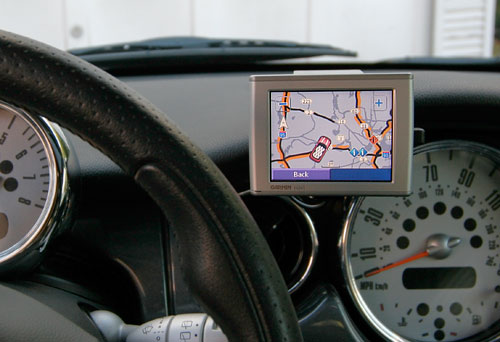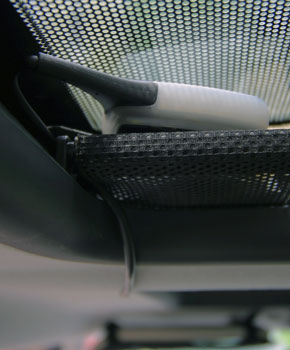The stock MINI navigation system costs $1700, removes the signature center speedometer, and uses the inferior BMW nav software. Before purchasing my MINI, I instead chose to build my own system that not only costs much less, but has a better 3-dimensional nav software. Now there are many great and easy to use navigation systems for just a few hundred dollars.
Like everything else in my MINI, I like to have things neatly mounted on the dashboard near line of sight and wired into the ignition. This is relatively simple to do for the GPS system. At least in Pre-05 MINIs, the front half of the dash top easily removes with 4-6 Torx20 screws so you can add a mount and hide wires. I use the excellent Kuda mount which clips onto this top dash in just the right place. ProClip also makes dash mounts as well as adaptors and cradles specific to the device you are using.

My newest nav unit is a Garmin Nuvi 370. It is small, thin, and portable, and includes Bluetooth handsfree and FM traffic data which are more useful for my daily commute. You may notice it has a MINI on the screen--that's thanks to MINI's own (overpriced) customized Nuvi 350, which the files can be copied from.
Below details my older Nav system, using some of the earliest TomTom software on a PocketPC, put together at half the price of the cheapest nav units in 2004.
Parts:
(1) TomTom Navigator software/GPS reciever/cradle $249.00us
(1) Compaq Ipaq PocketPC 3835 PDA $100.00us used from eBay
(1) Kuda-Phonebase dashboard mount $36.00us
(1) 256MB flash card $35.00us

The Ipaq 3835 was simply the cheapest going PocketPC available on eBay. I don't use it for any other purpose. The heart of the system is really the TomTom Navigator software. Most Nav systems use a 2-D overheard view that is not that easy to relate to while driving. TomTom allows you to switch between 2D and 3D modes, and also offers several useful POIs like restaurants and gas stations, which appear on the map as you drive by. The touch screen menus are very easy to use with your finger, and the directions are usually better planned than other systems. Onto the flash card I loaded the 160MB VA to ME map and a UK English voice, which is especially fun in Boston with all our "roundabouts."
Although the TomTom cradle kit comes with several excellent mounting options, the Kuda-Phonebase dashboard mount provides a perfectly placed, permanant mounting position. It is right in front of you and easy to read without taking your eyes off the road, but also not obstructing your view. Very easy to reach and easy to read the small text that may appear on screen. Although it can be installed without removing the dashboard, doing so involves only four screws and allowed me to hide all the cabling inside. The power is wired to the ignition so it turns on and off with the engine. With the use of a standard phone cable and extender, I ran the GPS cable inside the dash, up the A-pillar, through the roof, and along the sunroof molding. This allowed me to place the TomTom GPS receiver out of sight but in perfect view of the sky: inside the rear moonroof. I created a secure but removable mount out of the adhesive/magnetic tomtom mount, a metal bar, and a ziptie.

